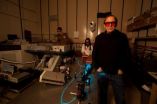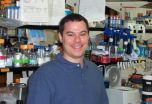(Press-News.org)
SALT LAKE CITY, Dec. 16, 2010 – University of Utah physicists stored information for 112 seconds in what may become the world's tiniest computer memory: magnetic "spins" in the centers or nuclei of atoms. Then the physicists retrieved and read the data electronically – a big step toward using the new kind of memory for both faster conventional and superfast "quantum" computers.
"The length of spin memory we observed is more than adequate to create memories for computers," says Christoph Boehme (pronounced Boo-meh), an associate professor of physics and senior author of the new study, published Friday, Dec. 17 in the journal Science. "It's a completely new way of storing and reading information."
However, some big technical hurdles remain: the nuclear spin storage-and-read-out apparatus works only at 3.2 degrees Kelvin, or slightly above absolute zero – the temperature at which atoms almost freeze to a standstill, and only can jiggle a little bit. And the apparatus must be surrounded by powerful magnetic fields roughly 200,000 times stronger than Earth's.
"Yes, you could immediately build a memory chip this way, but do you want a computer that has to be operated at 454 degrees below zero Fahrenheit and in a big national magnetic laboratory environment?" Boehme says. "First we want to learn how to do it at higher temperatures, which are more practical for a device, and without these strong magnetic fields to align the spins."
As for obtaining an electrical readout of data held within atomic nuclei, "nobody has done this before," he adds.
Two years ago, another group of scientists reported storing so-called quantum data for two seconds within atomic nuclei, but they did not read it electronically, as Boehme and colleagues did in the new study, which used classical data (0 or 1) rather than quantum data (0 and 1 simultaneously). The technique was developed in a 2006 study by Boehme, who showed it was feasible to read data stored in the net magnetic spin of 10,000 electrons in phosphorus atoms embedded in a silicon semiconductor.
The new study puts together nuclear storage of data with an electrical readout of that data, and "that's what's new," Boehme says.
The study was led by Boehme and first author Dane McCamey, a former research assistant professor of physics at the University of Utah and still an adjunct assistant professor. His main affiliation now is with the University of Sydney. Other co-authors were Hans van Tol of the National High Magnetic Field Laboratory in Tallahassee, Fla., and Gavin Morley of University College London.
The study was funded by the National High Magnetic Field Laboratory, the National Science Foundation, the Australian Research Council, Britain's Engineering and Physical Sciences Research Council and the Royal Commission for the Exhibition of 1851, a British funding agency led by Prince Philip.
Of Electronic and Spintronic Memories
Modern computers are electronic, meaning that information is processed and stored by flowing electricity in the form of electrons, which are negatively charged subatomic particles that orbit the nucleus of each atom. Transistors in computers are electrical switches that store data as "bits" in which "off" (no electrical charge) and "on" (charge is present) represent one bit of information: either 0 or 1.
Quantum computers – a yet-unrealized goal – would run on the odd principles of quantum mechanics, in which the smallest particles of light and matter can be in different places at the same time. In a quantum computer, one quantum bit or "qubit" could be both 0 and 1 at the same time. That means quantum computers theoretically could be billions of times faster than conventional computers.
McCamey says a memory made of silicon "doped" with phosphorus atoms could be used in both conventional electronic computers and in quantum computers in which data is stored not by "on" or "off" electrical charges, but by "up" or "down" magnetic spins in the nuclei of phosphorus atoms.
Externally applied electric fields would be used to read and process the data stored as "spins" – just what McCamey, Boehme and colleagues did in their latest study. By demonstrating an ability to read data stored in nuclear spins, the physicists took a key step in linking spin to conventional electronics – a field called spintronics.
Spin is an unfamiliar concept to comprehend. A simplified way to describe spin is to imagine that each particle – like an electron or proton in an atom – contains a tiny bar magnet, like a compass needle, that points either up or down to represent the particle's spin. Down and up can represent 0 and 1 in a spin-based quantum computer.
Boehme says the spins of atoms' nuclei are better for storing information than the spin of electrons. That's because electron spin orientations have short lifetimes because spins are easily changed by nearby electrons and the temperature within atoms.
In contrast, "the nucleus sits in the middle of an atom and its spin isn't messed with by what's going on in the clouds of electrons around the nucleus," McCamey says. "Nuclei experience nearly perfect solitude. That's why nuclei are a good place to store information magnetically. Nuclear spins where we store information have extremely long storage times before the information decays."
The average 112 second storage time in the new study may not seem long, but Boehme says the dynamic random access memory (DRAM) in a modern PC or laptop stores information for just milliseconds (thousandths of a second). The information must be repeatedly refreshed, which is how computer memory is maintained, he adds.
How to Store and Then Read Data in the Spins of Atomic Nuclei
For the experiments, McCamey, Boehme and colleagues used a thin, phosphorus-doped silicon wafer measuring 1 millimeter square, and placed electrical contacts on it. The device was inside a supercold container, and surrounded by intense magnetic fields. Wires connected the device to a current source and an oscilloscope to record data.
The physicists used powerful magnetic fields of 8.59 Tesla to align the spins of phosphorus electrons. That's 200,000 times stronger than Earth's magnetic field.
Then, pulses of near-terahertz electromagnetic waves were used to "write" up or down spins onto electrons orbiting phosphorus atoms. Next, FM-range radio waves were used to take the spin data stored in the electrons and write it onto the phosphorus nuclei.
Later, other pulses of near-terahertz waves were used to transfer the nuclear spin information back into the orbiting electrons, and trigger the readout process. The readout is produced because the electrons' spins are converted into variations in electrical current.
"We read the spin of the nuclei in the reverse of the way we write information," Boehme says. "We have a mechanism that turns electron spin into a current."
Summarizing the process, Boehme says, "We basically wrote 1 in atoms' nuclei. We have shown we can write and read [spin data in nuclei]," and shown that the information can be repeatedly read from the nuclei for an average of 112 seconds before all the phosphorus nuclei lose their spin information. In a much shorter time, the physicists read and reread the same nuclear spin data 2,000 times, showing the act of reading the spin data doesn't destroy it, making the memory reliable, Boehme says.
Reading out the data stored as spin involved reading the collective spins of a large number of nuclei and electrons, Boehme says. That will work for classical computers, but not for quantum computers, for which readouts must be able to discern the spins of single nuclei, he adds. Boehme hopes that can be achieved within a few years.
INFORMATION:
University of Utah Public Relations
201 Presidents Circle, Room 308
Salt Lake City, Utah 84112-9017
(801) 581-6773 fax: (801) 585-3350
www.unews.utah.edu
Computer memory takes a spin
Physicists read data after storing them in atomic nuclei for 112 seconds
2010-12-17
ELSE PRESS RELEASES FROM THIS DATE:
Why humans are more sensitive to certain viruses: Primate immune system differences identified
2010-12-17
The greater susceptibility of humans to certain infectious diseases when compared to other primates could be explained by species-specific changes in immune signaling pathways, a University of Chicago study finds. The first genome-wide, functional comparison of genes regulated by the innate immune system in three primate species discovers potential mediators of differences in disease susceptibility among primates. These findings are published on December 16 in the open-access journal PLoS Genetics.
Humans are more sensitive than chimpanzees to the severe effects of certain ...
Structural distortions emerge from nothing at the nanoscale
2010-12-17
December 16, 2010 - Scientists have discovered that a class of materials known to convert heat to electricity and vice versa behaves quite unexpectedly at the nanoscale in response to changes in temperature. The discovery - described in the December 17, 2010, issue of Science - is a new "opposite-direction" phase transition that helps explain the strong thermoelectric response of these materials. It may also help scientists identify other useful thermoelectrics, and could further their application in capturing energy lost as heat, for example, in automotive and factory ...
Using digitized books as 'cultural genome,' researchers unveil quantitative approach to humanities
2010-12-17
CAMBRIDGE, Mass. -- Researchers have created a powerful new approach to scholarship, using approximately 4 percent of all books ever published as a digital "fossil record" of human culture. By tracking the frequency with which words appear in books over time, scholars can now precisely quantify a wide variety of cultural and historical trends.
The four-year effort, led by Harvard University's Jean-Baptiste Michel and Erez Lieberman Aiden, is described this week in the journal Science.
The team, comprising researchers from Harvard, Google, Encyclopaedia Britannica, ...
Age doesn't matter: New genes are as essential as ancient ones
2010-12-17
New genes that have evolved in species as little as one million years ago – a virtual blink in evolutionary history – can be just as essential for life as ancient genes, startling new research has discovered.
Evolutionary biologists have long proposed that the genes most important to life are ancient and conserved, handed down from species to species as the "bread and butter" of biology. New genes that arise as species split off from their ancestors were thought to serve less critical roles – the "vinegar" that adds flavor to the core genes.
But when nearly 200 new ...
Light dawns on dark gamma-ray bursts
2010-12-17
Gamma-ray bursts (GRBs), fleeting events that last from less than a second to several minutes, are detected by orbiting observatories that can pick up their high energy radiation. Thirteen years ago, however, astronomers discovered a longer-lasting stream of less energetic radiation coming from these violent outbursts, which can last for weeks or even years after the initial explosion. Astronomers call this the burst's afterglow.
While all gamma-ray bursts [1] have afterglows that give off X-rays, only about half of them were found to give off visible light, with the ...
Most Medicare stroke patients rehospitalized or dead within year
2010-12-17
Nearly two-thirds of Medicare beneficiaries discharged from hospitals after ischemic stroke die or are readmitted within one year, researchers report in Stroke: Journal of the American Heart Association.
Stroke is the second leading cause of hospital admissions among older adults in the United States, according to American Heart Association/American Stroke Association statistics. Ischemic stroke, which occurs as a result of an obstruction within a blood vessel supplying blood to the brain, accounts for 87 percent of all strokes.
Only a few contemporary studies have ...
Most Medicare stroke patients die or are rehospitalized within year after discharge
2010-12-17
A UCLA-led has study found that after leaving the hospital, nearly two-thirds of Medicare beneficiaries hospitalized for acute ischemic stroke either died or were rehospitalized within a year.
The findings point to an opportunity for more quality-of-care initiatives to improve stroke care, especially in transitioning to home, stroke rehabilitation and outpatient care.
The study, which appears online Dec. 16 in Stroke, a journal of the American Heart Association, also found that hospital mortality and readmission rates varied widely nationwide, indicating there ...
Mount Sinai researchers develop mouse model to help find how a gene mutation leads to autism
2010-12-17
Researchers from Mount Sinai School of Medicine have found that when one copy of the SHANK3 gene in mice is missing, nerve cells do not effectively communicate and do not show cellular properties associated with normal learning. This discovery may explain how mutations affecting SHANK3 may lead to autism spectrum disorders (ASDs). The research is currently published in Molecular Autism.
"We know that SHANK3 mutation plays a central, causative role in some forms of autism spectrum disorders, but wanted to learn more about how it does this," said Joseph Buxbaum, PhD, Director ...
Tools used to decipher 'histone code' may be faulty
2010-12-17
CHAPEL HILL, N.C. – The function of histones -- the proteins that enable yards of DNA to be crammed into a single cell -- depends on a number of chemical tags adorning their exterior. This sophisticated chemical syntax for packaging DNA into tight little coils or unraveling it again -- called the "histone code" -- is the latest frontier for researchers bent on understanding how genetics encodes life.
But recent research from the University of North Carolina at Chapel Hill has found a number of issues with histone antibodies, the main tools used to decipher this code, ...
A 'spin ratchet': A new electronic structure for generating spin current
2010-12-17
A research team from the Institut Català de Nanotecnologia (ICN), in Barcelona, has demonstrated a device that induces electron spin motion without net electric currents, a key step in developing the spin computers of the future. The results are published in the Dec 17 issue of the journal Science. The authors are Marius V. Costache and Sergio O. Valenzuela, an ICREA Professor who is leader of the Physics and Engineering of Nanodevices Group at ICN.
Spintronics is a branch of electronics that aims to use the electron spin rather than its charge to transport and store ...
LAST 30 PRESS RELEASES:
Microplastics detected in rural woodland
JULAC and Taylor & Francis sign open access agreement to boost the impact of Hong Kong research
Protecting older male athletes’ heart health
KAIST proposes AI-driven strategy to solve long-standing mystery of gene function
Eye for trouble: Automated counting for chromosome issues under the microscope
The vast majority of US rivers lack any protections from human activities, new research finds
Ultrasound-responsive in situ antigen "nanocatchers" open a new paradigm for personalized tumor immunotherapy
Environmental “superbugs” in our rivers and soils: new one health review warns of growing antimicrobial resistance crisis
Triple threat in greenhouse farming: how heavy metals, microplastics, and antibiotic resistance genes unite to challenge sustainable food production
Earthworms turn manure into a powerful tool against antibiotic resistance
AI turns water into an early warning network for hidden biological pollutants
Hidden hotspots on “green” plastics: biodegradable and conventional plastics shape very different antibiotic resistance risks in river microbiomes
Engineered biochar enzyme system clears toxic phenolic acids and restores pepper seed germination in continuous cropping soils
Retail therapy fail? Online shopping linked to stress, says study
How well-meaning allies can increase stress for marginalized people
Commercially viable biomanufacturing: designer yeast turns sugar into lucrative chemical 3-HP
Control valve discovered in gut’s plumbing system
George Mason University leads phase 2 clinical trial for pill to help maintain weight loss after GLP-1s
Hop to it: research from Shedd Aquarium tracks conch movement to set new conservation guidance
Weight loss drugs and bariatric surgery improve the body’s fat ‘balance:’ study
The Age of Fishes began with mass death
TB harnesses part of immune defense system to cause infection
Important new source of oxidation in the atmosphere found
A tug-of-war explains a decades-old question about how bacteria swim
Strengthened immune defense against cancer
Engineering the development of the pancreas
The Journal of Nuclear Medicine ahead-of-print tip sheet: Jan. 9, 2026
Mount Sinai researchers help create largest immune cell atlas of bone marrow in multiple myeloma patients
Why it is so hard to get started on an unpleasant task: Scientists identify a “motivation brake”
Body composition changes after bariatric surgery or treatment with GLP-1 receptor agonists
[Press-News.org] Computer memory takes a spinPhysicists read data after storing them in atomic nuclei for 112 seconds


